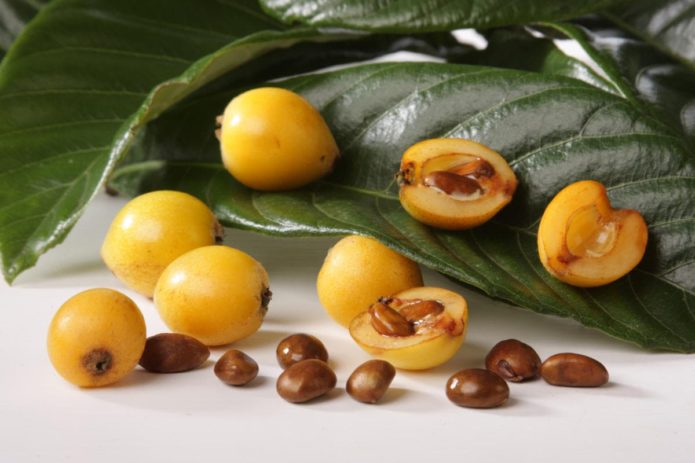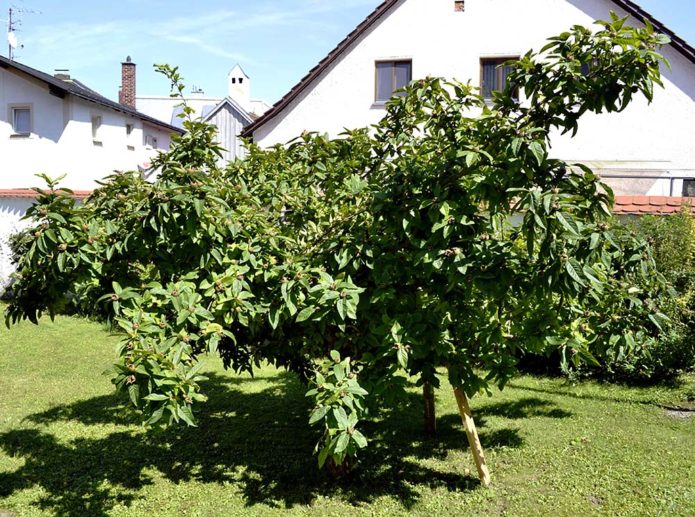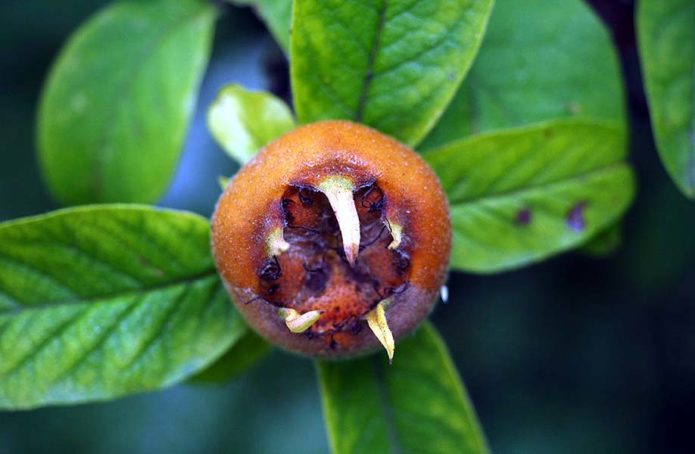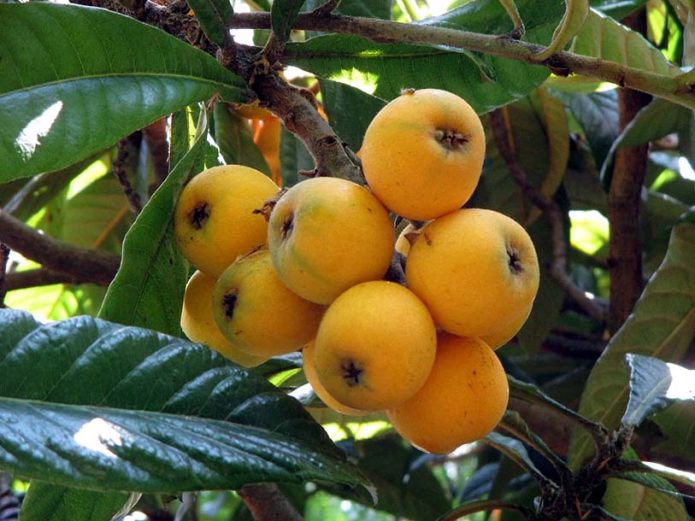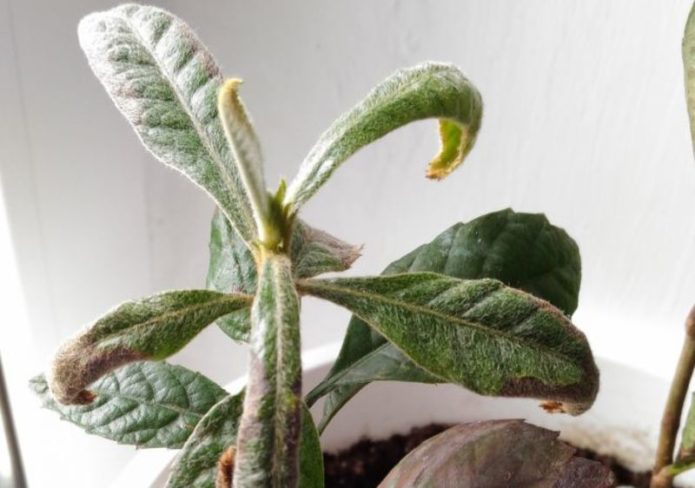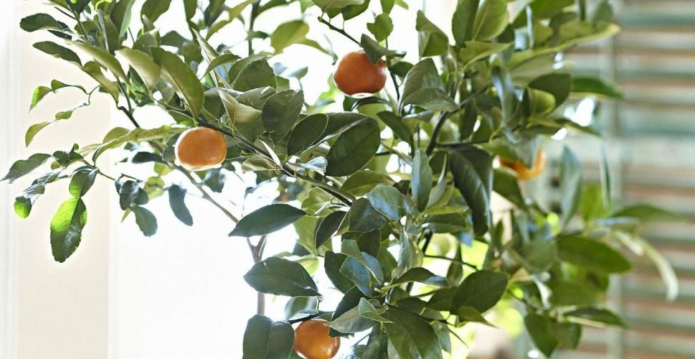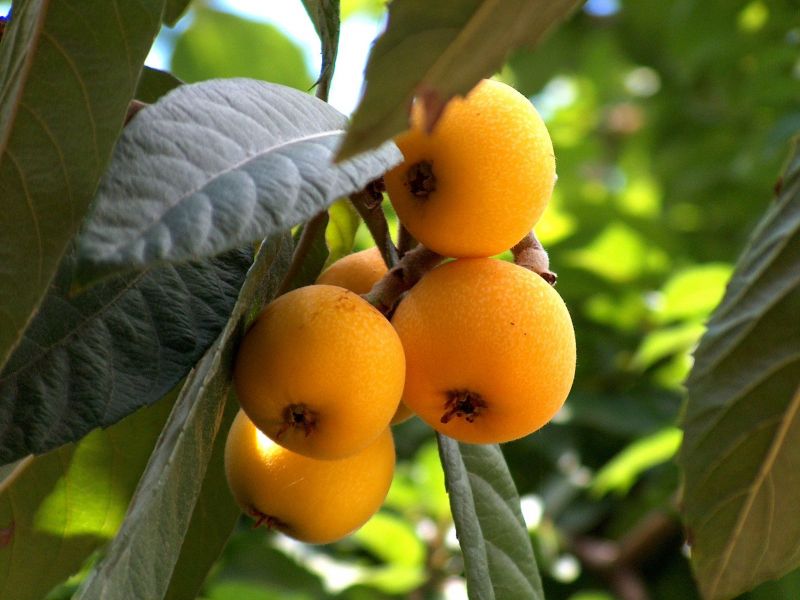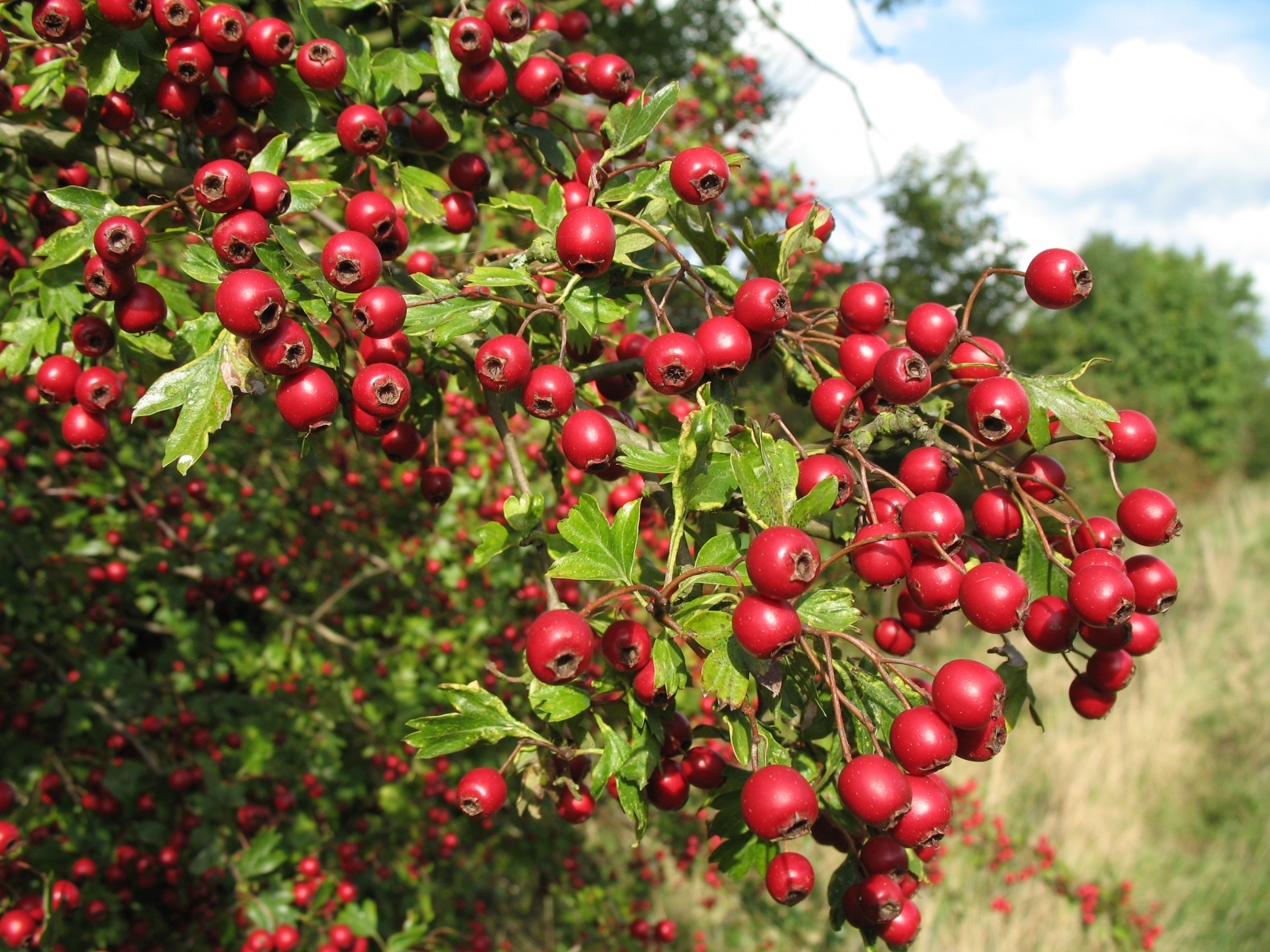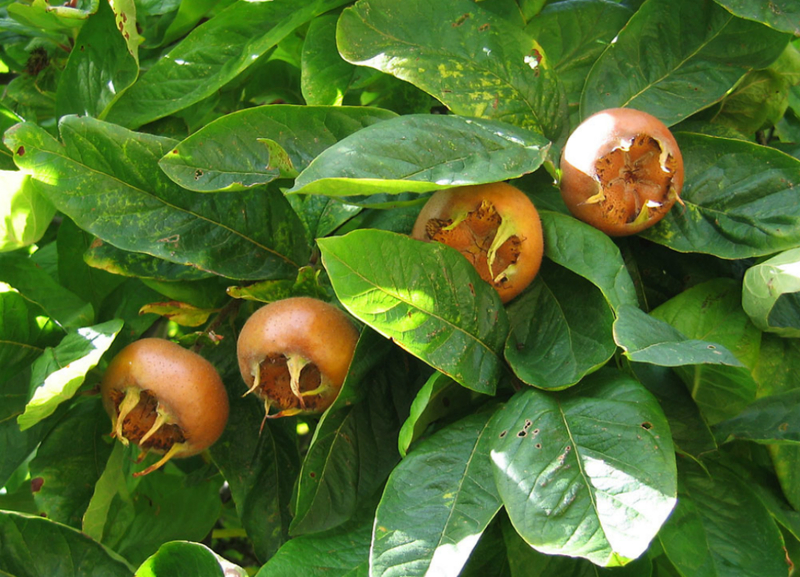Among the traditional for Russian gardens and summer cottages of apple trees, pears and other fruit and berry crops, loquat appears more and more often. The plant is also known as ezgil, the cup tree. The presence of several forms and varieties of this culture, reacting differently to weather characteristics, allows gardeners to get a tasty harvest not only in the southern regions, but also in more severe climatic zones - of course, provided that all agrotechnical nuances are observed.
Content
Medlar - what is this fruit?
Up to 7 years old, this plant is considered young and develops rapidly, then the activity decreases slightly, but resumes with the same strength after 13 years, in order to delight its owners with beauty and harvests for many years.
You can grow a plant not only in the open field, but also at home, on a loggia or balcony. Depending on which of the options is preferable, the appropriate variety is selected.
For landscape designers, medlar is a real find: the tree is beautiful in any season, winter-hardy, so it can be planted on the north side of the garden to serve as a natural protection for more delicate plants. Here are some uses for medlar.
A tree with a spreading crown that looks attractive even without leaves can be made the focal point of a small garden.
The medlar looks great with beautiful foliage, delicate flowers and bright fruits in group plantings.
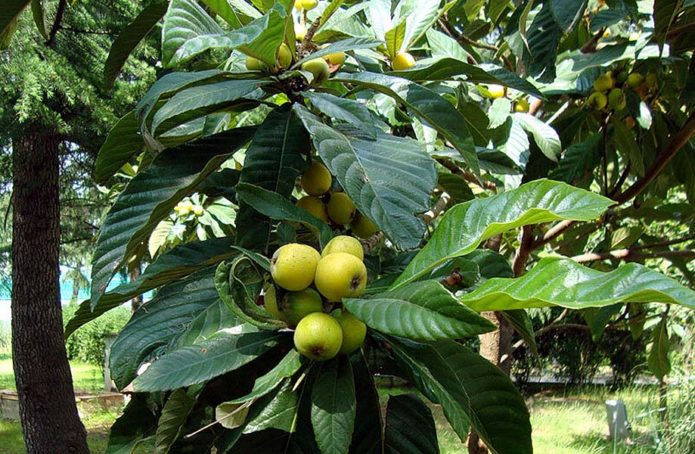
In landscape design, graceful compact trees are more often used that can coexist with other cultures.
Neat alleys are created from young trees, since any kind of crown can be formed on a medlar - the plant tolerates a haircut perfectly.
The methods of pruning and shaping the crown of the medlar are similar to those for apple trees:https://flowers.desigusxpro.com/en/uhod-za-rasteniyami/obrezka-yablon-osenyu.html
Plants grown under a roof in pots and flowerpots are taken out into the garden for the summer to make decorative compositions.
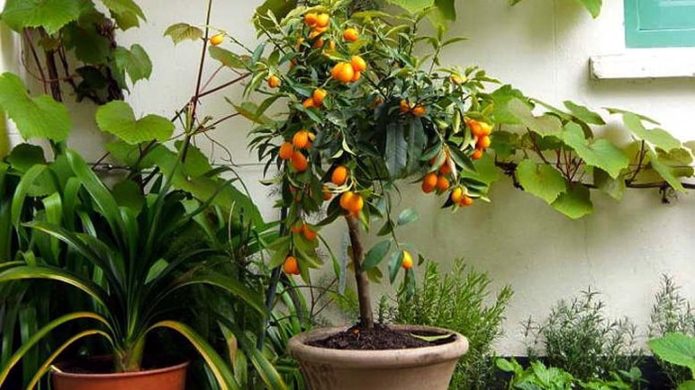
A medlar grown in a flower pot is no less attractive and is often used to create decorative compositions.
The fruits (orange in some varieties and brown in others) are tasty and healthy. They contain many vitamins and minerals, which retain valuable properties not only fresh, but also in compotes, jams, and drinks. Medlar is rich in antioxidants, helps to stabilize blood pressure, improves vision, is included as a dietary product in the menu of diabetics (100 g of berries - 47 kcal). The fruit is appreciated by cosmetologists - masks made from its pulp improve skin color and smooth wrinkles.
Contraindications for the use of medlar are diseases of the gastrointestinal tract and individual intolerance to this fruit.
Where it grows better
The most favorable for medlar are regions where winter temperatures do not fall below 0°C, and sharp cold snaps (down to –15 ° C) are rare and short-term. In Russia, such regions include the Krasnodar Territory, Crimea, the Black Sea coast of the Caucasus.
Experts consider the medlar a hardy plant that can withstand both severe drought and severe frosts, however, they recommend promoting only those varieties that will pass these tests to colder climatic zones. For example, for growing in the open field in the Moscow region or in the Urals, the Japanese medlar is hardly suitable, in which at a temperature of -17°With the branches die, and at -23 ° C - the whole tree.
The German medlar is more resistant to cold weather, it can withstand frosts down to -35 ° С.
It is important to take into account climatic features not only because of the fear of losing the plant in a frosty winter. If it does not have enough heat, it will survive, but it will not bear fruit at all, or it will yield a crop every two years or even five years only if there are comfortable temperatures.
The medlar is not very demanding on the structure of the soil; both sand and clayey heavy earth will suit it. It is better if it is a soil with a neutral pH. On acidic podzolic soils, the plant will not be able to give a good harvest. The danger to the root system of the medlar is posed by closely lying groundwater - even if they are at a distance of 1 m from the surface of the earth, such a site for this culture will not be suitable.
Popular types and varieties of medlar (photo)
Of interest in terms of breeding in Russia are two types of medlar.
German (Caucasian, Crimean)
This species is hastily grown in most Russian regions - the plant has a crown of about 3 m, blooms in early spring and has time to bear fruit by the end of the season.
The varieties of the Germanic species include Medlar Sladkaya Dracheva. Outwardly, the fruits resemble yellow plums with a diameter of 3 cm, on the surface of which light brown splashes are visible. The variety is late, winter-hardy.
Another popular variety Caucasian medlar - Khvamli. In open ground, the tree grows to an average of 1.8 m. It is drought-resistant and winter-hardy.
Japanese (eriobotria, shesek, lokva)
Medlar Japanese in the open ground of central Russia is grown more often as an ornamental culture, but in closed conditions and in the south it gives a crop.
Of the varieties Japanese medlar, which are intended for greenhouses and rooms, Morozko stands out. The fruits are very tasty, not tart, medium-sized. Fruit color is red-brown.
The Champagne variety is also interesting. Its fruits are larger, yellow, and pear-shaped. The taste is sweet, tender.
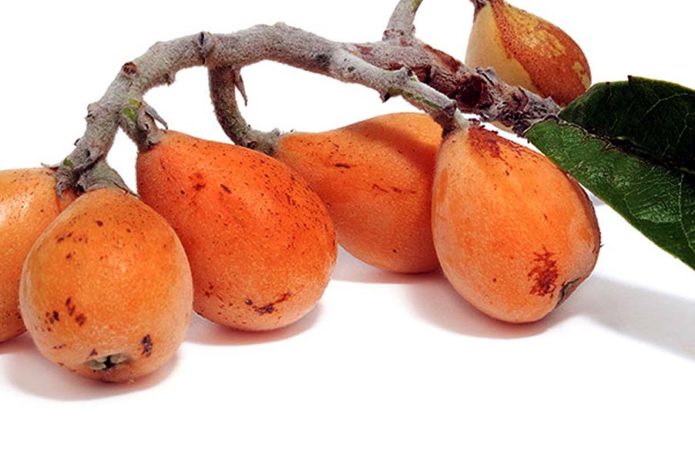
The fruits of the Champagne medlar are very similar to apricots, since they have a similar pubescence
Planting methods
Medlar can be grown from seeds by sowing them directly into open ground. Seeds are planted in the fall. It should be borne in mind: when this procedure is carried out in nature, the sprout makes its way only 2–3 years after it enters the soil. A person can speed up the process by stratifying the seeds (keeping them in the cold) for 3-4 months. The cold test is usually preceded by a 5 hour soak in a 3% sulfuric acid solution and rinse in clean water.
Further work with seeds will be like this:
- Immediately before planting, the seeds are soaked for 24 hours in warm water or in a growth stimulator such as Kornevin.
- The seeds are deepened into the ground by about 2 cm.
- The landing site is mulched with sawdust, peat, as an option, a film shelter is used.
- Shoots should appear in the spring.
Many gardeners, for example, in the Moscow region, prefer to grow seedlings at home, rather than sowing seeds in open ground. In this case, the procedure is as follows:
- The bones are soaked in Kornevin's solution for 5 hours.
- The disinfected containers are filled with soil mixture (it should be slightly acidic, with good aeration).
- The seeds are deepened by 1 cm.
- They organize a film shelter, which is removed for a short time in order to water and ventilate the crops.
- The same care and protection will be required for those who appear after 1.5 months. sprouts.
- If several plants have sprung up in the container, they are seated separately at the stage of 1-2 pairs of true leaves.
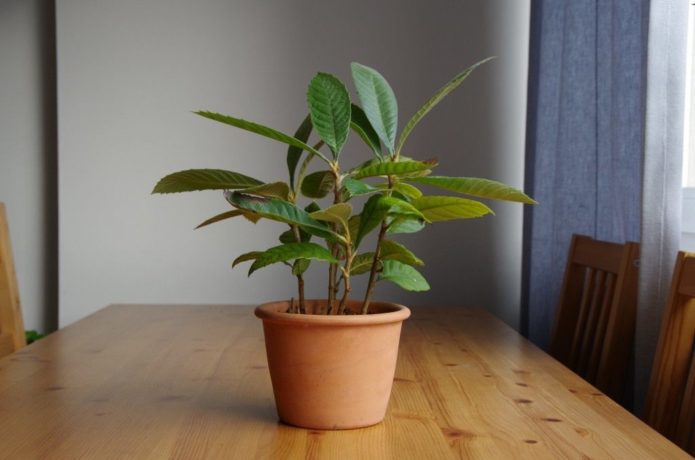
Indoor plants in pots will not take root in the open field, so it is better to leave store plants at home.
In regions with a warm climate, seedlings can be immediately planted in open ground, the ideal time for this is the beginning of autumn. In the conditions of the Moscow region, two options are possible: continue to keep the seedlings at home until spring, and then plant, or transfer the plants to a heated greenhouse, plant them there, and transplant them into open ground in the spring.
The soil for seedlings should be well dug up with the addition of bone meal. Plants are lowered into the prepared recesses along with a lump of earth, they try to plant it exactly the same depth as in the pot, and watered well.
Other ways of breeding medlar:
- root suckers;
- air layering (a container with moist soil is tied to the branches, from which a little bark has been removed);
- cuttings (2-year-old shoots are used);
- you can also plant medlar on quince, hawthorn or mountain ash.
Instructions for using the biostimulator Kornevin for plants:https://flowers.desigusxpro.com/en/uhod-za-rasteniyami/udobreniya/instrukciya-po-primeneniyu-biostimulyatora-kornevin-dlya-rasteniy.html
Leaving after disembarkation
Caring for a medlar is not very difficult for a gardener and consists mainly of watering and dressing. In addition, you need to take care of the decorativeness of the plant, forming its crown.
During growth and fruiting
Medlar needs regular watering, especially the first 4 years, when there is an active growth of branches, but it can suffer due to waterlogging, therefore, stagnation of water in the near-trunk circle should be avoided. By the way, it can be mulched so that in hot weather the soil retains moisture longer.
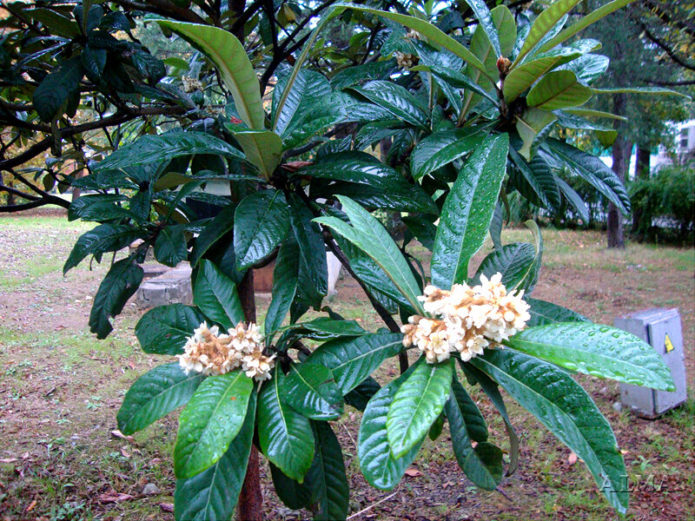
The flowering of medlar can last up to a month, the inflorescences themselves have the smell of bitter almonds
The loquat is fed with organic matter a year after the rooting of the plant in the open field. Then every year he needs 2-3 additional feeding during the season: mullein, phosphate nitrate, potash fertilizers, wood ash.
To protect plants from diseases and pests, insecticides "Fitoverm" or "Insegar" are used.
It is recommended to prune medlar every spring. Not only shoots damaged and frozen over the winter are subject to removal, but also those that grow incorrectly
- perpendicular to the trunk,
- too close to the branches on which the crop usually ripens,
- those that are strongly curved.
Preparing for winter
If after flowering a lot of ovaries have formed on the branches, experts advise to remove some of them so that the harvest is of better quality. In a medlar, which bears fruit for the first time, it is advisable to leave only 10 fruits.
German medlar ripens in the fall, but it is recommended to harvest only after frost, when the fruits become truly sweet, resembling jam in taste and consistency. This becomes clear when the fruit is broken.
The winter hardiness of the medlar is quite high, so it is not required to cover the plant even in regions such as the Moscow region or the Urals. However, the tree does not become resistant immediately, it is still advisable to insulate the young shoots: the root circle - with foliage and humus, the crown - with lutrasil or other covering material. Plants from unheated verandas, loggias and balconies must bring in a house for the winter, since in a small amount of soil, the medlar root system will definitely freeze.
In the southern regions, where the Japanese medlar is usually grown, young plants are also tried to be protected when there is a threat of frost, for example, with frames made of cardboard boxes.And on the bunches of flowers and ovaries, they put on bags of thick paper, tying them to the branches.
What problems do gardeners have with growing medlar
Sometimes planting medlar can require special attention from its owner, especially in cases where:
- The leaves dry first at the edges, and then die completely. This problem usually occurs in winter due to dryness in an overly warm room. The solution is regular spraying, and not the plant itself, but the air around it.
- Black spots appear on the leaves in winter. Most likely, this is a consequence of a fungal disease, and it develops in a cold (less than + 15 ° C) room after frequent watering. The way to prevent the situation is to reduce the number of waterings, and to refuse spraying altogether.
- The leaves become soft, like a rag. The reason is the dryness of the earthen coma. The solution to the problem is to water the plant and remember to do it regularly.
- There is no flowering. The reason - during the rest period, the medlar was actively fed and watered, "knocking down" its regime. The solution is to further give the plant a full rest.
- Plants in the open field suffer from sooty fungus and scale insects. The solution is to treat the plantings with chemicals purchased in specialized stores.
On the biological features of the scale insect and how to deal with it:https://flowers.desigusxpro.com/en/bolezni-rasteniy/kak-borotsya-s-schitovkoy-na-komnatnyh-rasteniyah-sovety-i-foto.html
Video: recommendations for cultivation in the Krasnodar Territory
How to grow at home
When growing room medlar from seeds at home, there are nuances. The secret of the planting material lies in the fact that the viability of the bone remains only for three days after being removed from the pulp. The lengthening of this period is fraught with the fact that the sprout may not hatch at all or, which is also very disappointing, the future plant will be sterile.
Landing is carried out as follows:
- They purchase the necessary substrate in the store or make up from sand, leafy earth, peat and humus (all components are taken equally).
- A layer of expanded clay is poured at the bottom of the pot, then the earth and moisten them.
- For each pot, 6 seeds are taken and deepened into the soil by 2 cm.
- Covering the pot with foil, put it on a warm light windowsill.
- The sprouts that appear after 1 month will need shading from the bright sun and airing. The condensation that accumulates under the film is removed so that the plants do not suffer from fungal infections.
- The film is removed when the medlar grows to 2 cm.The temperature at this time should not be lower than +18°FROM.
- Plants are watered no more than 2-3 times a week.
- Then the medlar must be planted in separate pots. The right moment for this will come when the height of the plants reaches 15 cm.
Is the medlar worth the trouble? Of course yes. This plant with beautiful leaves will bloom in 3 years, and by the New Year will delight its owner with the first fruits.
Medlar is designed for gardeners who are not used to "waiting for the mercy of nature" and content with only those crops that were traditionally grown by their predecessors. Thanks to the efforts of breeders, varieties have been bred that can today decorate gardens in different regions of Russia and give you the opportunity to enjoy unusual fruits.
